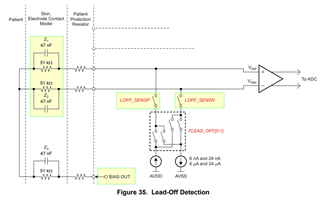Hi there,
I've spent a fair amount of time trying to figure out how to implement Figure 35 in the SBAS499C-pdf - the "Lead-Off Detection".
The text in section "9.3.2.4.3 Lead-Off Detection" reads:
"Lead-off can be selectively done on a per channel basis using the LOFF_SENSP and LOFF_SENSN registers."
However, it's not clear to me if I should enable both excitation signal switches (LOFF_SENSN and LOFF_SENSP)?
Does the current flow from LOFF_SENSN to LOFF_SENSP?
Or does it depend on whether or not the BIAS-output (also on Figure 35) is enabled?
According to this post, https://e2e.ti.com/support/data-converters-group/data-converters/f/data-converters-forum/1168088/ads1299-can-i-engage-bias-loop-which-reduces-common-mode-noise-in-impedance-measurement-mode/4394754, it is claimed that it may but done without the BIASOUT:
"So, customers could try/test how the AC Lead-off detection works(in terms of sensitivity and stability) as when you attach or detach the BIASOUT electrode/patch from UUT and/or turning On/Off the BIAS Amp."


